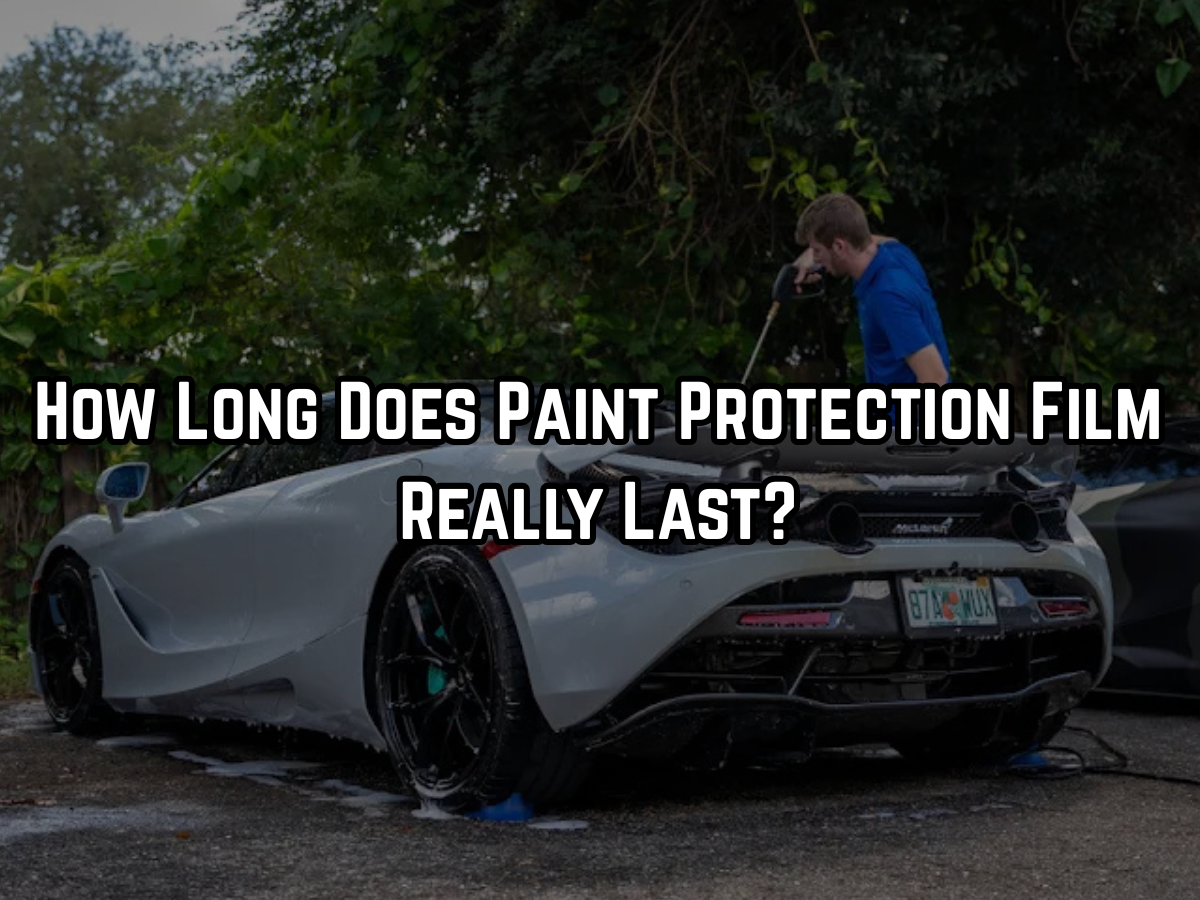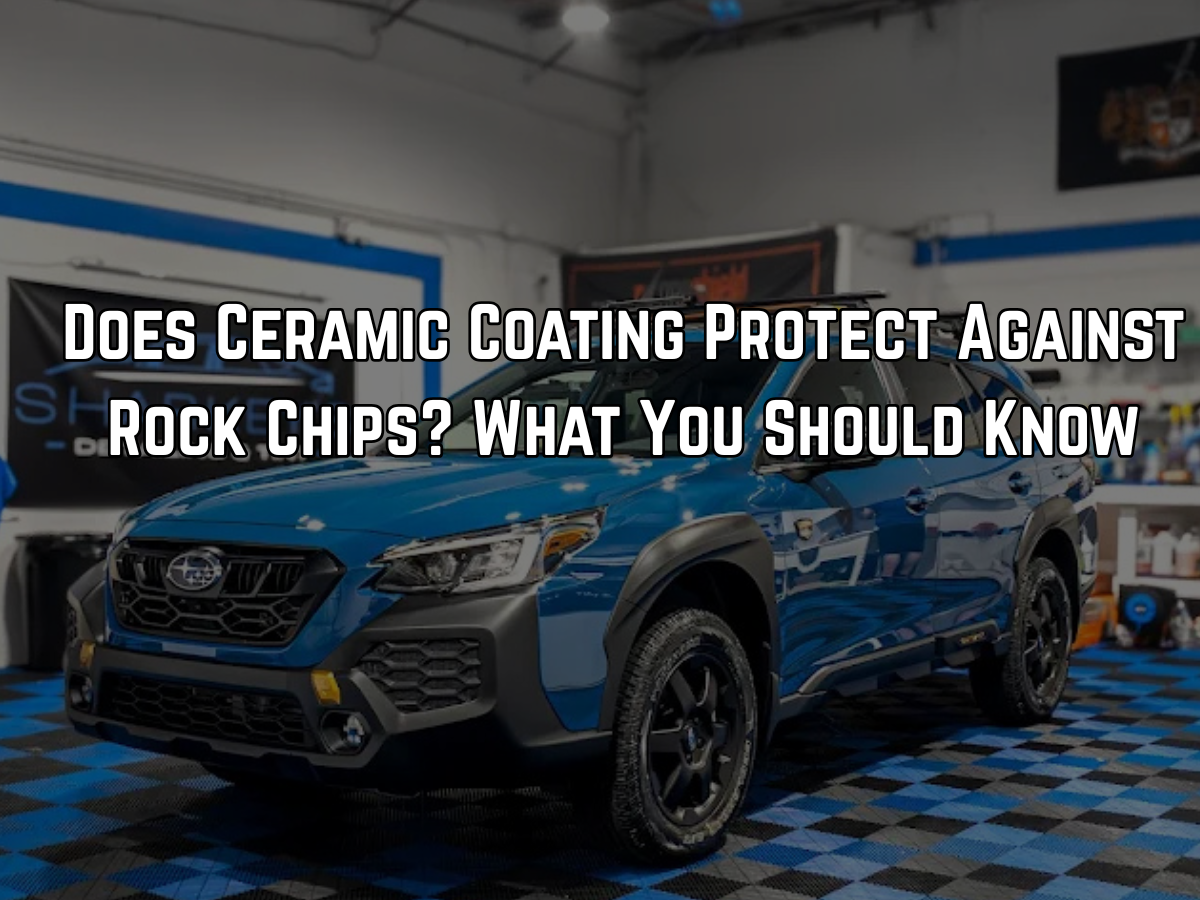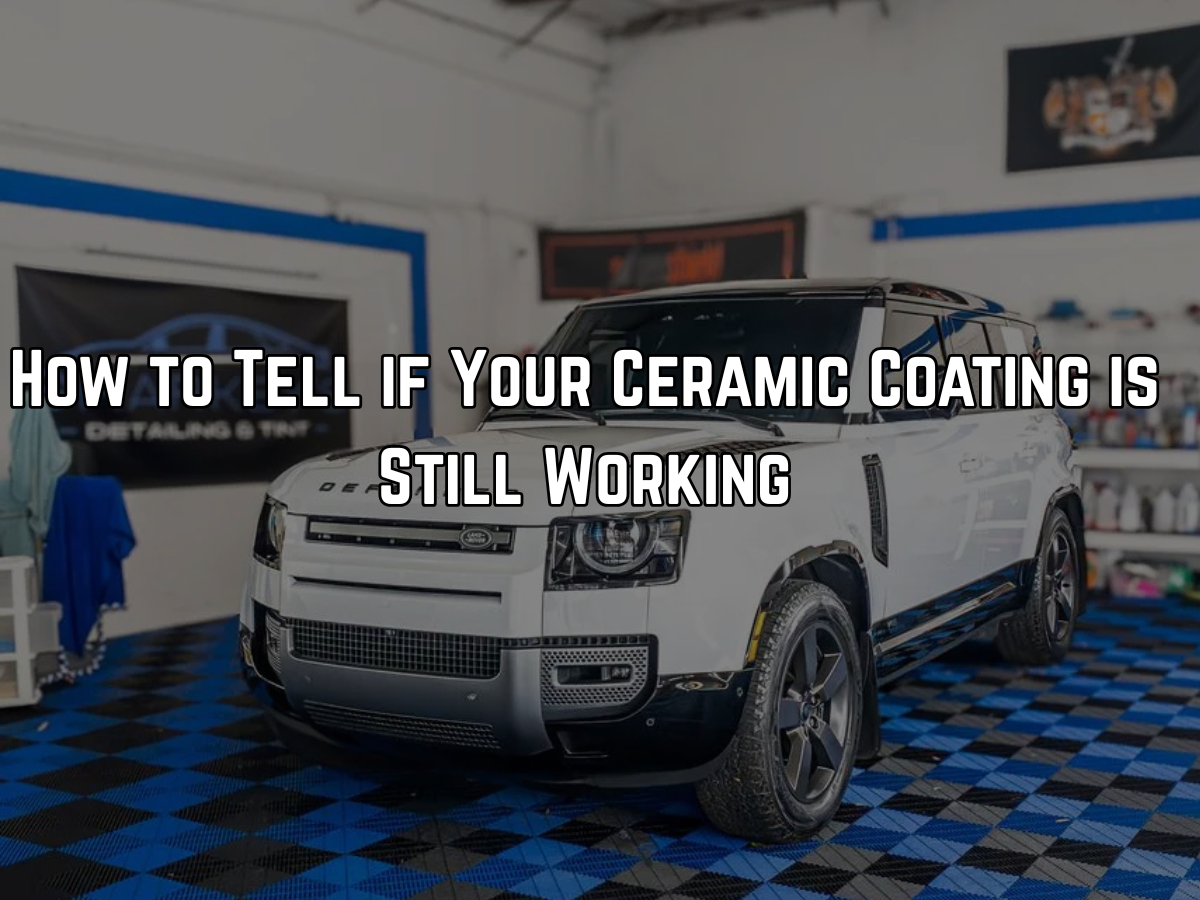How Long Does Paint Protection Film Really Last?
You're considering paint protection film for your car. The installer mentions a 10-year warranty, and you're thinking that sounds great. But then you start wondering: does the film actually last that long, or is this one of those situations where the warranty is meaningless because the product fails in other ways not covered?
What to Expect
Quality paint protection film typically lasts 7 to 10 years when properly maintained, though Florida's intense UV exposure often pushes that toward the lower end of the range. Budget films might only give you 3 to 5 years before yellowing, edge lifting, or adhesive failure becomes problematic. The actual lifespan depends heavily on installation quality, maintenance habits, sun exposure, and whether you park in a garage or outside. Self-healing top coats wear out before the film itself, usually losing effectiveness after 5 to 7 years of constant UV bombardment.

Understanding PPF's Physical Composition
Paint protection film is thermoplastic polyurethane, a material chosen specifically for its durability and impact resistance. The film consists of multiple layers working together to protect your paint.
The base adhesive layer bonds to your clear coat. This adhesive is pressure-sensitive and engineered to stick firmly without leaving residue when properly removed. Adhesive breakdown is often the first failure point in lower-quality films
The main urethane layer provides the actual protection. This is where the film's thickness (typically 6 to 8 mils) creates a buffer against rock chips, scratches, and environmental damage. The urethane has elastomeric properties, meaning it can flex and absorb impacts without tearing.
The self-healing top coat sits on the surface and allows minor scratches to disappear with heat application. This layer is chemically distinct from the urethane beneath it and typically wears out faster than the base film. After years of UV exposure, the self-healing properties diminish even though the film continues protecting against impacts.
UV inhibitors are mixed throughout the film to prevent yellowing and degradation from sun exposure. These inhibitors break down over time, which is why older PPF eventually yellows or becomes brittle.
The 7 to 10 Year Reality
When manufacturers say their film lasts 7 to 10 years, they're making assumptions about conditions and maintenance. Let's break down what that timeframe actually means.
Year 1 to 3: The film performs at peak level. Self-healing works perfectly, water beads up strongly, and the film looks virtually invisible. Any issues during this period typically result from installation problems, not film degradation.
Year 4 to 6: Self-healing begins losing effectiveness, especially on horizontal surfaces like the hood that face constant UV exposure. The film still protects against rock chips and scratches, but minor surface scratches may not heal as completely as they once did. Water beading decreases slightly as the top coat weathers.
Year 7 to 10: The film enters its final phase. Self-healing is largely gone, though impact protection remains. Edge lifting may begin in high-stress areas like bumper corners. Some yellowing might appear, though quality films resist this better than budget options. The film still functions as a protective barrier but no longer performs like new.
Beyond 10 years, most PPF shows visible degradation. Yellowing becomes more apparent, especially on white cars. Edge lifting spreads from corners to larger sections. The adhesive may begin failing, causing bubbles or hazing under the film. At this point, removal and replacement makes sense.
Florida's Impact on PPF Lifespan
Living in Sarasota changes the PPF longevity equation. Florida's environment is uniquely harsh on automotive films.
- UV intensity in Florida ranks among the highest in the continental United States. The sun's radiation breaks down UV inhibitors in the film faster than in northern states. A film rated for 10 years in Michigan might realistically last 7 to 8 years here. The difference is significant and predictable.
- Heat cycles stress the film daily. Florida temperatures can push surface temperatures on black cars to 160 to 180 degrees Fahrenheit. This constant heating and cooling makes the film expand and contract, gradually weakening adhesive bonds at the edges.
- Salt air near the coast accelerates edge corrosion. While PPF itself resists salt, the adhesive edges can accumulate salt deposits that eventually work their way under the film. Cars parked within 2 miles of the ocean face this problem more than inland vehicles.
- Humidity affects how contaminants interact with the film. High moisture content means water spots, if left unaddressed, etch into the film's top coat more aggressively. The self-healing layer breaks down faster when constantly fighting mineral deposits.
Realistically, expect quality PPF to last 7 to 8 years in Florida with proper care. That's not a failure of the product. It's just the reality of this environment. Budget films? You'll be lucky to get 5 years before serious problems develop.
Installation Quality Makes or Breaks Longevity
The best film in the world won't last if poorly installed. Installation quality directly affects how long your PPF performs well.
Edge sealing determines how long it takes for lifting to begin. Professional installers wrap film edges around panel boundaries when possible or create clean, secure edges that resist peeling. Poor edge work means lifting starts within 2 to 3 years instead of 6 to 8.
Surface preparation before installation impacts adhesion. The paint must be completely clean, decontaminated, and free of waxes or sealants. Any contamination between the adhesive and clear coat creates weak points where the film fails prematurely. I've seen DIY installations fail within months because the installer didn't properly prep the paint.
Stretch and tension during installation matter. Installers must stretch the film just enough to conform to curves without overstretching. Overstretched film contracts over time, pulling away from edges. Understretched film creates bubbles and loose areas that fail early.
Environment during installation affects adhesion too. Installing in dusty or humid conditions introduces contaminants or prevents proper adhesive bonding. Professional shops maintain controlled environments specifically to avoid these problems.
Computer-cut patterns versus hand-cutting also impacts quality. Computer-cut patterns fit precisely and minimize handling, reducing contamination risk. Hand-cutting requires more skill and introduces more variables that can affect longevity.
Maintenance Requirements for Maximum Lifespan
PPF doesn't protect itself. How you maintain the film determines whether it reaches its full lifespan or fails early.
Washing frequency should be every 2 weeks minimum. Contaminants sitting on PPF break down the self-healing top coat faster. Bird droppings, bug guts, and tree sap are particularly damaging if left for days. Regular washing removes these threats before they cause permanent damage.
Wash method matters almost as much as frequency. Use pH-neutral car shampoo and soft microfiber wash mitts. Avoid automatic car washes with harsh brushes that scratch the film. Never use high-pressure washers directly on film edges, which can cause lifting.
Wax and sealant application on PPF is debated. Some installers recommend it; others don't. If you do apply wax or sealant, use products specifically labeled as PPF-safe. Regular car waxes can yellow certain films or interfere with self-healing properties. A better option is ceramic coating over the PPF, which protects the film while enhancing water behavior.
Edge monitoring should happen during every wash. Check corners, seams, and high-stress areas for any lifting. Catching edge lift early lets you address it before water and contaminants get under the film. Once contamination gets under the film, removal becomes the only option.
Contaminant removal requires promptness. Don't let bug splatter, bird droppings, or tree sap sit on PPF for more than 24 hours. These acidic contaminants etch into the self-healing layer and can cause permanent staining or damage over time.
Signs Your PPF is Reaching End of Life
PPF doesn't fail suddenly. It degrades gradually, giving you warning signs that replacement is approaching.
- Yellowing appears first on the edges, then spreads inward. White and light-colored cars show this most obviously. Slight yellowing might be acceptable, but once the yellow tint becomes noticeable from 10 feet away, the film has lost most of its UV inhibitors and will only get worse.
- Edge lifting starts in corners and high-stress areas. Small edge lifts can sometimes be resealed, but widespread lifting across multiple panels means the adhesive is failing. Once lifting begins, it accelerates because water and contaminants get under the film.
- Hazing or clouding under the film indicates adhesive breakdown. The normally crystal-clear appearance becomes slightly milky or foggy. This happens when moisture penetrates the adhesive layer. Once hazing appears, it won't improve and will spread.
- Loss of self-healing is normal after 5 to 7 years but indicates the film is in its final phase. Light scratches that used to disappear with heat now remain visible. The film still protects against impacts, but the surface appearance degrades.
- Bubbles or wrinkles that weren't there originally suggest adhesive failure or film contraction. Small bubbles sometimes appear and disappear with temperature changes, which is normal. Large bubbles or bubbles that persist indicate problems.
- Staining that won't clean away means contaminants have penetrated the self-healing layer and bonded to the urethane beneath. This permanent discoloration signals that the top coat has failed.
Budget vs Premium PPF Lifespan Differences
Not all paint protection film is created equal. The price difference between budget and premium films reflects real differences in durability and longevity.
Budget films (typically bottom-tier products) might last 3 to 5 years before showing significant yellowing or adhesive failure. These films use less sophisticated UV inhibitors and cheaper adhesives. They often lack self-healing properties entirely or have weak self-healing that stops working after 2 years. Budget film makes sense for short-term protection on leased vehicles or older cars you don't plan to keep long.
Mid-tier films from reputable manufacturers typically deliver 5 to 7 years of good performance. They include self-healing top coats and adequate UV inhibitors. These films represent the sweet spot for most car owners, balancing cost and performance. They won't last the full 10 years claimed, especially in Florida, but they provide solid protection for a reasonable timeframe.
Premium films from top manufacturers push toward the full 10-year lifespan, even in harsh conditions. These films use the best UV inhibitors, strongest adhesives, and most durable self-healing coatings. The premium is significant, but if you're keeping your car 10+ years and want one installation to last, premium film justifies the investment.
The warranty backing matters too. Premium films typically include comprehensive 10-year warranties covering yellowing, cracking, bubbling, and staining. Budget films might offer 3 to 5 year warranties with numerous exclusions. Read warranty terms carefully because they reveal manufacturer confidence in the product's longevity.
Extending PPF Life Beyond the Expected Range
With exceptional care, you can push PPF beyond its typical lifespan. Here's what that takes.
- Garage parking dramatically extends film life. Avoiding constant UV exposure preserves UV inhibitors and self-healing properties. Garaged PPF in Florida can reach that full 10-year mark while outdoor-parked film struggles to hit 7 years.
- Regular ceramic coating maintenance over the PPF protects the film's top coat from UV damage and makes cleaning easier. Reapplying ceramic coating every 2 to 3 years gives the PPF an extra layer of defense against environmental degradation.
- Professional film maintenance every year or two catches problems early. Professional detailers can address minor edge lifting before it becomes serious, remove embedded contaminants that regular washing misses, and assess the film's overall condition. This proactive approach prevents small issues from becoming big failures.
- Avoiding extended sun exposure when possible helps. If you work from home, park in shade or cover the car during peak sun hours. Even a car cover provides some UV protection, though PPF is designed to be the final surface and doesn't require covering under normal circumstances.
- Prompt removal and replacement of damaged sections prevents contamination from spreading under surrounding film. If one panel's film fails, replacing just that panel protects the rest of the installation.
When to Remove PPF
Knowing when to remove PPF is as important as knowing how long it lasts. Remove too early and you waste remaining protection. Wait too long and removal becomes difficult or damages your paint.
- Remove when yellowing becomes unacceptable. Slight yellowing might be tolerable, but once it's obvious to anyone looking at your car, replacement time has come. Yellowed film doesn't improve and will only get worse.
- Remove when edge lifting spreads across multiple panels. Isolated edge lift in one corner isn't urgent. Widespread lifting means the adhesive is failing globally and removal should happen soon before contamination gets under the film everywhere.
- Remove when hazing or clouding appears under the film. This indicates adhesive breakdown. The longer you wait, the harder removal becomes and the more likely you'll have adhesive residue issues.
- Remove proactively at the 8 to 10 year mark even if the film looks okay. Film becomes harder to remove as it ages. Waiting until it looks terrible might mean difficult removal that risks paint damage.
Professional removal is recommended for aged film. The adhesive becomes more aggressive over time, and improper removal can pull clear coat or leave stubborn residue. Professionals use heat guns and proper techniques to remove aged film safely.
PPF Removal and Paint Condition
One advantage of PPF over other protection methods is that your paint underneath remains pristine. The film has protected it from chips, scratches, UV damage, and contamination. When you remove 10-year-old PPF, the paint underneath often looks showroom fresh.
However, unprotected areas of your car have aged during those 10 years. The contrast can be striking. Your hood and bumpers (covered by PPF) look brand new while your roof and trunk (not covered) show fading, oxidation, and minor scratches. This mismatch might require paint correction on unprotected areas to match the protected panels' appearance.
After PPF removal, most people immediately reinstall new film to maintain that protection. The paint is in excellent condition and worth protecting for another 7 to 10 years. Others switch to ceramic coating or other protection methods depending on their needs and budget.
Real-World Lifespan Observations
After years in the detailing business, certain patterns in PPF lifespan become obvious.
- Cars driven daily that see 15,000+ miles per year typically hit the lower end of lifespan ranges. The constant exposure to road debris, varying weather, and regular cleaning wears the film faster than occasional-use vehicles.
- Garage-kept cars driven occasionally can exceed stated lifespan by 2 to 3 years. I've seen premium film on garaged sports cars still looking good at the 12-year mark, though self-healing was long gone.
- Dark-colored cars show film degradation less than light colors. Slight yellowing that's obvious on white paint might not be noticeable on black paint. This doesn't mean the film lasts longer on dark colors; it just means the degradation is less visible.
- Front bumpers and hoods always degrade fastest. These surfaces face constant UV exposure, more impacts, and higher temperatures. Film on side mirrors and fenders often outlasts film on horizontal surfaces by 1 to 2 years.
- Coastal cars see accelerated edge failure compared to inland vehicles. Salt air works its way into film edges and accelerates lifting. Cars parked 5+ miles inland experience noticeably better edge longevity.
Making the Installation Decision
Understanding realistic PPF lifespan helps you make informed decisions about whether, when, and where to install it.
- New cars benefit most from immediate PPF installation. The paint is perfect, requiring no correction before application. The film protects that pristine condition for years. Waiting even 6 months means the paint accumulates chips and scratches that remain visible under the film forever.
- Recently repainted panels are prime candidates for PPF. You've invested in perfect paint. Protecting it immediately maximizes your investment.
- High-impact areas only makes sense for budget-conscious owners. Full hood, front bumper, and mirror coverage provides protection where it matters most. Other areas can go without PPF if chemical protection is more important than impact resistance.
- Full-vehicle coverage makes sense for expensive cars, show cars, or vehicles you plan to keep 10+ years. The investment is substantial, but protecting the entire vehicle from both impacts and environmental damage pays off over time.
For those considering PPF installation or needing guidance on whether the film is right for their situation, information about protection options is available through professional detailing consultations.
The Bottom Line on PPF Longevity
Quality paint protection film realistically lasts 7 to 10 years with proper maintenance. Florida's environment pushes that toward 7 to 8 years for most installations. Budget films won't make it past 5 years before showing serious degradation.
Installation quality matters as much as film quality. Poor installation cuts lifespan in half. Regular maintenance extends lifespan and keeps the film looking good throughout its service life.
Watch for yellowing, edge lifting, and hazing as signs that replacement time is approaching. Remove and replace film proactively rather than waiting for complete failure, which makes removal harder and risks paint damage.
PPF provides excellent protection during its lifespan, preserving your paint in like-new condition. When you finally remove the film, your paint underneath looks years newer than the rest of the car. That protection is the whole point, and quality PPF delivers it consistently for 7 to 10 years before requiring replacement.




